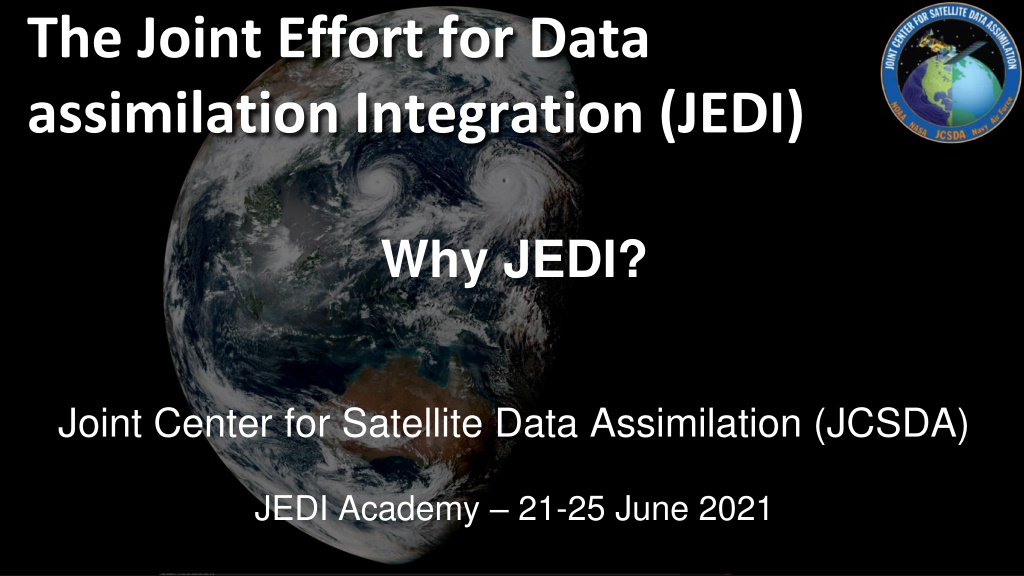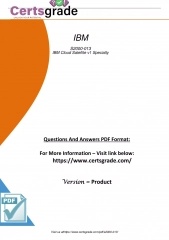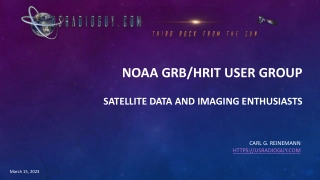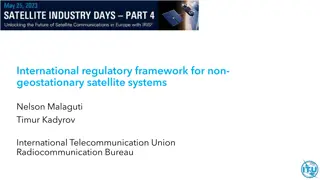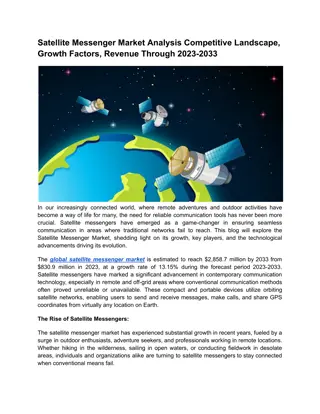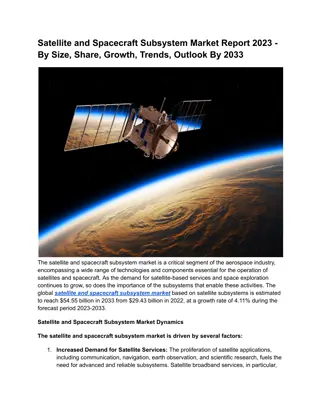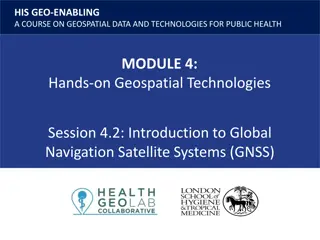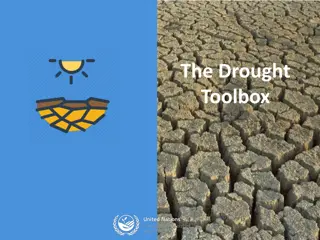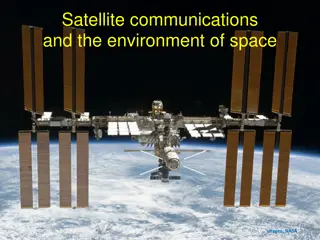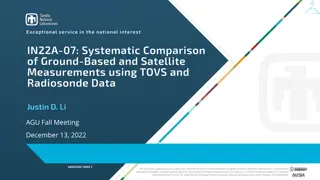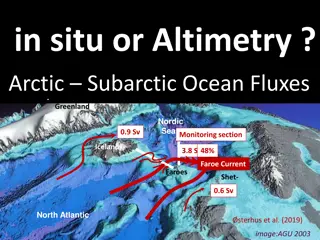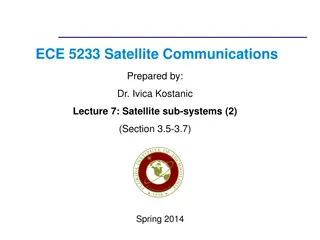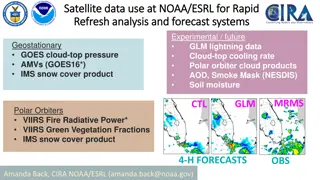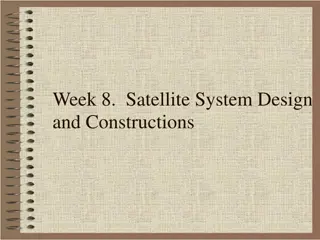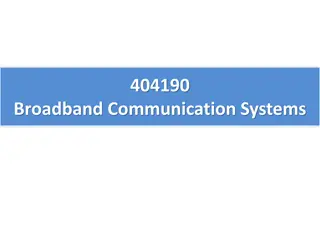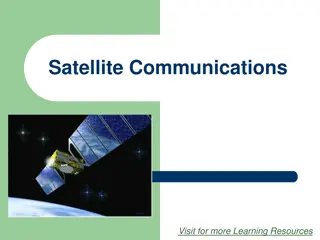Advancing Satellite Data Integration for Environmental Analysis
The Joint Center for Satellite Data Assimilation (JCSDA) operates as a multi-agency research center aimed at enhancing the use of satellite data for weather, ocean, climate, and environmental analysis. Organized under key projects like JEDI and CRTM, JCSDA focuses on algorithm development and observation processing to improve Earth system prediction. With a proactive stance towards evolving data assimilation challenges, JCSDA is paving the way for unified approaches to leverage diverse Earth system observations effectively for enhanced predictive capabilities.
Download Presentation

Please find below an Image/Link to download the presentation.
The content on the website is provided AS IS for your information and personal use only. It may not be sold, licensed, or shared on other websites without obtaining consent from the author. Download presentation by click this link. If you encounter any issues during the download, it is possible that the publisher has removed the file from their server.
E N D
Presentation Transcript
The Joint Effort for Data assimilation Integration (JEDI) Why JEDI? Joint Center for Satellite Data Assimilation (JCSDA) JEDI Academy 21-25 June 2021
The Joint Center for Satellite Data Assimilation (JCSDA)
Joint Center for Satellite Data Assimilation A multi-agency research center created to improve the use of satellite data for analyzing and predicting the weather, the ocean, the climate and the environment. Collaborative organization funded by - NOAA/NWS - NOAA/NESDIS - NOAA/OAR - NASA/GMAO - US Navy - US Air Force
Joint Center for Satellite Data Assimilation A multi-agency research center created to improve the use of satellite data for analyzing and predicting the weather, the ocean, the climate and the environment. Organized by projects: - CRTM (Community Radiative Transfer Model) - JEDI (Joint Effort for Data assimilation Integration) - SOCA (Sea-ice Ocean Coupled Assimilation) - OBS (Improved use of Observations) - LAND (Land surface Data Assimilation)
JCSDA: Same Mission, New Approach The JCSDA mission remains the same. However, as compared with the time of JCSDA s founding (c.2000), the rapid evolution of operational NWP toward coupled models and assimilation systems, combined with the expected proliferation of new observations from components of the Earth system other than the atmosphere, demand new and more unified approaches to algorithm development, observation processing, and maintenance of software. Increasing numbers and diversity of observations from multiple components of the Earth system Relatively few new data types for NWP, but improved usage of the above, still primarily atmospheric data types. Major increases in the number of atmospheric sounder radiances with real- time data delivery for operational NWP 2000 2010 2020 2030 Coupled DA, of various flavors, becomes the standard. Benefits of OO coding, JEDI, coupling and mutualizing algorithms. All-sky, all-surface radiances, hybrid DA techniques, transition other data types, reorg. of JCSDA for future challenges. Funding of the JCSDA, CRTM, new observations put into the NCEP system (e.g. AIRS). The JCSDA is taking a proactive approach to current and future satellite data assimilation challenges to reposition the research and operational communities in the US to take full advantage of the coming era of full Earth system prediction.
JEDI is a Joint Effort JEDI core-team: Anna Shlyaeva, Benjamin M n trier, Claude Gibert, Cl mentine Gas, Dan Holdaway, Eric Lingerfelt, Mark Miesch, Maryam Abdi, Rick Grubin, Steve Herbener, Steve Vahl, Yannick Tr molet JEDI contributors: Andrew Collard, Ben Ruston, Byoung-Joo Jung, Chris Harrop, Cory Martin, David Davies, David Rundle, David Simonin, Emily Liu, Guillaume Verni res, Hailing Zhang, Hamideh Ebrahimi, Hui Shao, JJ Guerrette, Jeff Whitaker, Jim Rosinski, Junmei Ban, Louis Kouvaris, Louis Wicker, Marek Wlasak, Mariusz Pagowski, Mike Cooke, Ming Hu, Rahul Mahajan, Ryan Honeyager, Sarah King, Sergey Frolov, Steve Sandbach, Travis Sluka, Virginie Buchard, Will McCarty, Wojciech migaj, Yali Wu, Yanqiu Zhu, Yaswant Pradhan, Yunheng Wang, Representing: JCSDA, NOAA/EMC, NOAA/ESRL, NASA/GMAO, NCAR, UKMO, NRL And about 200 padawans who attended five JEDI Academies (more soon!) JCSDA JEDI
JEDI: Motivations and Objectives Reduce duplication of effort between JCSDA partners - Adding new observations (UFO and IODA) - Implementation of new DA algorithms (OOPS) Bring all components of Earth-system in one DA system - Develop DA algorithms once for all components (OOPS) - Enable future coupled DA developments (OOPS) For research and operations (and O2R2O)
JEDI: Approach Modern DA systems are too complex for any one person to grasp entirely - Collaborative developments - Separation of concerns Modernize software - Speed-up future developments - Ease maintenance - Increase portability and efficiency
Object Oriented Prediction System (OOPS) Generic, portable, model- agnostic DA system Abstract Layer - OOPS Forecast EnKF 4D-Var Use object-oriented and generic programing Uses State Model Covariance Obs. Each model implements pre- defined abstract interfaces Implements Lorenz FV3 + GSI MOM6 Separation of concerns
JEDI: Abstraction and Genericity Abstract Layer Generic Algorithms Forecast 4D-Var EDA EnKF Abstract, model-agnostic DA system Uses Abstract Interfaces State Model Covariance Obs. Operator Obs. Space OOPS is complemented by generic (shared) components. Generic Layer Implements Generic Implementations SABER UFO IODA Specific Implementations MOM6 FV3 NEPTUNE GNSSRO CRTM
Model design Between model steps OOPS calls post-processors - OOPS manages when post-processors are called - Post-processing removed from model code (separation of concerns) create( ) Setup (lots of stuff) initialize( ) step( ) Timestep Post-processors isolate data assimilation from the model (separation of concerns) - Computing simulated observations H(x) - Jc-DFI, finalize() Clean-up (sometimes) destruct() Post-processors do not modify the State Y. Tr molet, JCSDA JEDI
Models Interfacing MODEL TYPE CENTER FV3GFS Atmosphere NOAA-EMC GEOS Atmosphere NASA-GMAO FV3GFS GSDChem Atmospheric chemistry NOAA-ESRL GEOS-AERO Atmospheric aerosols NASA-GMAO MPAS Atmosphere NCAR WRF Atmosphere NCAR LFRic Atmosphere Met Office (UK) UM Atmosphere Met Office (UK) MOM6 Ocean NOAA-EMC SIS2 Sea ice NOAA-EMC CICE6 Sea ice NOAA-EMC NEPTUNE Atmosphere NRL QG Toy model ECMWF Lorenz 95 Toy model ECMWF Shallow Water Toy model NOAA-ESRL JCSDA JEDI
Unified Forward Operator (UFO) Share observation operators between JCSDA partners and reduce duplication of work - Taking the model agnostic approach one level down into the observation operators Faster use of new observing platforms - Regular satellite missions are expensive - Cube-sat have short expected life time - Include users and instruments science teams Unified Forward Operator (UFO) - Build a community app-store for observation operators JCSDA JEDI
Observation Operators Obs. Operators State Observations In most (all) existing systems, observation operators directly access state/model data Observation operators, and as a result DA systems, are very model specific
Unified Forward Operator (UFO) Same separation of concerns principles that lead to the design of OOPS Obs. Locations Variables Obs. Operators Observations State Field Values at Locations JEDI/UFO introduces standard interfaces between models and observations Observation operators are independent of the model and can easily be shared, exchanged, compared
UFO Observation filters Abstract observation filters are called before and after the obs. operator Observation filters are generic and have access to - Observation values and metadata - Model values at observations locations (GeoVaLs) - Simulated observation value and diagnostics (for post-filter) - Their own private data Filters are written once and used with many observation types Generic filters already exist for: - Gross error check, background check, blacklisting, thinning - Entirely controlled from yaml configuration file(s) More filters will be developed as needed - Generic filters should cover most needs JCSDA JEDI
UFO Validation against GSI (ASMU-A) NOAA-15 NOAA-18 Std. Dev. Mean GDAS operational platforms/sensors (~GFSv15.3) were tested by JCSDA for one cycle using EMC provided obs and geovals NOAA-19 METOP-A Code/configurations are in github repo (develop) Figures from JCSDA OBS team (H. Shao et al.) Obs # passed GSI QC GSI and UFO values on top of each other # difference between JEDI and GSI Qced observations JEDI
JEDI-GODAS: Observations Generic Quality Control: No Coding! Figures from SOCA team JEDI
Typical Observation Data Flow Plots Plots Plots? Plots Monitoring Monitoring? Diagnostics? Diagnostics Toolset 1 Toolset 2 Toolset 3? Toolset 4 Format 1 Format 2 Format 3 Format 4 Pre-proc. Decoding DA DA GTS Network Obs. files Obs. files Obs. files Diag. files @ DA time Pre-proc. Observer Solver Save? Save Save Save Research Tape Tape Tape Tape This is not sustainable: - maintenance and evolution are impossible - does not fit possible evolution of DA methods (continuous assimilation) JCSDA JEDI/IODA
Observation Data Flow with IODA Plots Diagnostics Monitoring Decoding GTS IODA DA Network Pre- processing One observation data handling interface across the whole NWP chain, ideally across the entire memory hierarchy (memory, disk, archive) JCSDA JEDI
JEDI Working Practices Many people, many organizations, many models How is fast progress possible?
Infrastructure, working practices Project methodology inspired by Agile/SCRUM Adapted to distributed teams and part time members Work in small manageable increments with constant feedback Collaborative environment Easy access to up-to-date source code (github) Easy exchange of information (zenhub) Pull requests and code reviews (all developers actively involved) Regular meetings by video Code sprints (8-10 developers working together on a specific topic) Object-oriented programming and independence of code components (separation of concerns)
Code and repositories UFO (Unified Forward Operator) The app-store of model-agnostic observation operators NEPTUNE OOPS (Object Oriented Prediction System) Full data assimilation generic algorithms CRTM (Community Radiative Transfer Model) Accurately and efficiently simulate satellite radiances FV3GFS CRTM GEOS UFO OOPS MPAS IODA (Interface for Observation Data Access) Performs all the I/O of the observations IODA LFRic SABER (System-Agnostic Background Error Representation) Generic background error covariance (incl. BUMP) SABER WRF MOM6 Abstract interfaces (separation of concerns) are the most important aspect of the design The end of the monolithic gigantic jumble of code CICE5 JCSDA JEDI
Infrastructure, working practices Enforce software quality - Correctness, coding norms, efficiency Continuous Integration, Testing framework - Toolbox for writing tests - Automated running of tests (on pull requests) Effort on portability - Flexible build system (ecbuild, cmake-based) - Automatically run tests with several compilers - JEDI available in containers (singularity, charliecloud) Documentation - Doxygen, sphynx, (readthedocs)
Bringing people in: JEDI Academy June and Nov. 2018, June 2019, Feb. and Nov. 2020 4 days of lectures and practical sessions with the code - - Y. Tr molet, JCSDA
Bringing people in: Code Sprints One specific topic Gather 8-10 people in a room for 1 or 2 weeks Develop solutions (not a workshop) Efficient use of part time contributors Involve people from partner institutions Very motivating (before, during, after) NCAR, JCSDA, OAR, EMC, NRL, NASA JCSDA, NCAR, GMAO, OAR, EMC, M t o-France, Met Office, NRL Y. Tr molet, JCSDA JEDI
Long term collaborations Collaborative work implies/requires - Quick code reviews (a few hours to a few days) - Code is in, doesn t mean it is used in operations Distinguish steps - Technical developments - Scientific evaluation - Move to operations - With constant feedback (Agile, DevOps) JEDI is making DA tools available to (operational) JCSDA partners.
Final Comments JEDI is bringing modern software development technologies and working practices to the data assimilation community - The technologies in use are all proven in the software industry - Changing working habits/practices is the most challenging aspect, it takes time In the future joint data assimilation environment: - Technical infrastructure is shared as much as possible - Common components (H, B, R ) are made available to all the partners when/where it makes sense - Each partner keeps their own applications and choice of components and data assimilation algorithm they use The keys to success are separation of concerns and interfaces
